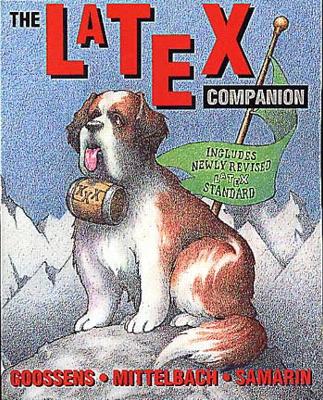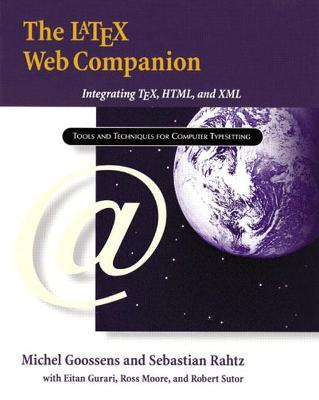Tools and Techniques for Computer Typesetting
2 total works
The LaTeX Companion
by Michel Goossens, Frank Mittelbach, and Alexander Samarin
Published 10 February 1994
LaTeX is an accessible and effective tool for typesetting written documents. Users at all levels of experience, however, sometimes require help not readily available: techniques for defining new commands, styles for producing tables or graphics, explanations for changing fonts. This book, The LaTeX Companion, is packed with information needed to use LaTeX even more productively. It is a true companion to Leslie Lamport's original user's guide book, LaTeX: A Document Preparation System, now in its second edition, and indeed, it is a valuable complement to any LaTeX introduction. It is designed to enhance, not to replace, your basic documentation. Coinciding with the publication of The LaTeX Companion is the availability of a revised LaTeX standard LaTeX2e. This new release incorporates important LaTeX developments over the past several years and provides a common basis for all LaTeX enhancements. Some new styles, improved font handling, and a facility to produce PostScript graphics are included in the release. As part of the broad and unique coverage of this book you will find a complete documentation for all these added features.
Highlights *Covers all versions of LaTeX now in use, including LaTeX2e. *Describes over 150 convenient styles for floats, graphics, tables, and much more. *Shows how to define new commands and environments. *Explains the use of PostScript. *Covers the latest extensions and programs producing pictures, indexes, bibliographies, and advanced mathematics. *Includes techniques for multi-language support. *Describes the New Font Selection Scheme. For even more information about how to illustrate documents with TeX and PostScript, see The LaTeX Graphics Companion and the Tools and Techniques for Computer Typesetting Series. All three authors have for years been involved in the support and development of LaTeX applications. Michel Goossens and Alexander Samarin, developed ideas for The LaTeX Companion while supporting hundreds of LaTeX users at CERN, and Frank Mittelbach, at the University of Mainz and Electronic Data Systems. The questions most frequently posed to them became the questions answered in this book.
Mittelbach is partly responsible for the current maintenance of LaTeX and is the author or coauthor of many widespread LaTeX extension packages, such as AMS-LaTeX, doc, multicol, and the New Font Selection Scheme. He is also the manager, principal architect of the longer-term LaTeX3 project, to which half the royalties from this book are paid. 0201541998B04062001
Highlights *Covers all versions of LaTeX now in use, including LaTeX2e. *Describes over 150 convenient styles for floats, graphics, tables, and much more. *Shows how to define new commands and environments. *Explains the use of PostScript. *Covers the latest extensions and programs producing pictures, indexes, bibliographies, and advanced mathematics. *Includes techniques for multi-language support. *Describes the New Font Selection Scheme. For even more information about how to illustrate documents with TeX and PostScript, see The LaTeX Graphics Companion and the Tools and Techniques for Computer Typesetting Series. All three authors have for years been involved in the support and development of LaTeX applications. Michel Goossens and Alexander Samarin, developed ideas for The LaTeX Companion while supporting hundreds of LaTeX users at CERN, and Frank Mittelbach, at the University of Mainz and Electronic Data Systems. The questions most frequently posed to them became the questions answered in this book.
Mittelbach is partly responsible for the current maintenance of LaTeX and is the author or coauthor of many widespread LaTeX extension packages, such as AMS-LaTeX, doc, multicol, and the New Font Selection Scheme. He is also the manager, principal architect of the longer-term LaTeX3 project, to which half the royalties from this book are paid. 0201541998B04062001
LaTeX Web Companion, The
by Michel Goossens, Sebastian Rahtz, Eitan M. Gurari, Ross Moore, and Robert S. Sutor
Published 23 July 1999
This book shows how you can publish LaTeX documents on the Web. LaTeX was born of the scientist's need to prepare well-formatted information, particularly with pictures and mathematics included; the Web was born of the scientist's need to communicate information electronically. Until now, it has been difficult to find solutions that address both needs. HTML and today's Web browsers deal inadequately with the nontextual components of scientific documents. This book, at last, describes tools and techniques for transforming LaTeX sources into Web formats for electronic publication, and for transforming Web sources into LaTeX documents for optimal printing.
You will learn how to: *Make full use of Acrobat with LaTeX *Convert existing documents to HTML or XML *Use mathematics in Web applications *Use LaTeX to prepare Web pages *Read and write simple XML/SGML *Produce high-quality printed pages from Web-hosted XML or HTML pages You will find practical descriptions of: *LaTeX2HTML, which uses Perl to interpret LaTeX source and generate HTML *TeX4ht, which redefines LaTeX's macros to generate HTML or XML *Browser plugins, such as techexplorer, that are able to interpret mathematical markup directly *Tools for authoring and interpreting XML *Tools for translating XML into various output formats, using Cascading Style Sheets, DSSSL, or XSL *Mathematical Markup Language (MathML) In addition to giving the Internet location of the software described in this book, the authors also provide a full, annotated catalogue of URLs for the standards and documentation relating to this fast-moving area. Many of the packages and programs described in this book are freely available in public software archives, and the source code for examples has been placed on CTAN, the TeX archives. 0201433117B04062001
You will learn how to: *Make full use of Acrobat with LaTeX *Convert existing documents to HTML or XML *Use mathematics in Web applications *Use LaTeX to prepare Web pages *Read and write simple XML/SGML *Produce high-quality printed pages from Web-hosted XML or HTML pages You will find practical descriptions of: *LaTeX2HTML, which uses Perl to interpret LaTeX source and generate HTML *TeX4ht, which redefines LaTeX's macros to generate HTML or XML *Browser plugins, such as techexplorer, that are able to interpret mathematical markup directly *Tools for authoring and interpreting XML *Tools for translating XML into various output formats, using Cascading Style Sheets, DSSSL, or XSL *Mathematical Markup Language (MathML) In addition to giving the Internet location of the software described in this book, the authors also provide a full, annotated catalogue of URLs for the standards and documentation relating to this fast-moving area. Many of the packages and programs described in this book are freely available in public software archives, and the source code for examples has been placed on CTAN, the TeX archives. 0201433117B04062001

